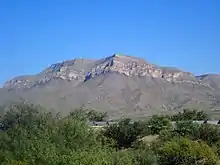Nakaye Formation
The Nakaye Formation is a geologic formation in the Caballo Mountains of New Mexico. It preserves fossils dating back to the middle Pennsylvanian.[1]
| Nakaye Formation Stratigraphic range: middle Pennsylvanian | |
|---|---|
 Timber Mountain, New Mexico, USA, is capped with 200 feet of cherty limestone of the Nakaye Formation. | |
| Type | Formation |
| Underlies | Bar B Formation |
| Overlies | Red House Formation |
| Thickness | 419 feet (128 m) |
| Lithology | |
| Primary | Limestone |
| Location | |
| Coordinates | 33.0231°N 107.2347°W |
| Region | New Mexico |
| Country | United States |
| Type section | |
| Named for | Nakaye Mountain |
| Named by | V.C. Kelley and Caswell Silver |
| Year defined | 1952 |
 Nakaye Formation (the United States)  Nakaye Formation (New Mexico) | |
Description
The Nakaye Formation is mostly massive ledges of gray to dark gray, very fine to fine grained limestone with considerable bands, lenses,and nodules of chert. Typical beds are 10–25 feet (3.0–7.6 meters) in thickness and are separated by shale beds 1–2 feet (0.30–0.61 m) thick or thin to medium-bedded limestone 5–10 feet (1.5–3.0 m) thick. Sandstone is absent.[2]
The formation is 419 feet (128 m) thick and lies conformably on the Red House Formation. It is overlain by the Bar B Formation.[2]
The formation is of middle Pennsylvanian age and may correlate with the Lead Camp Limestone in the San Andres Mountains, the Gobbler Formation in the Sacramento Mountains, and the Los Moyos Limestone of the Manzano Mountains.[1]
History of investigation
The formation was first defined by V.C.Kelley and Caswell Silver in 1952.[2] Bachman and Myers criticized its definition in 1975,[1] but it is accepted by Kues and Giles.[3]
Footnotes
- Bachman and Myers 1975
- Kelley and Caswell 1952
- Kues and Giles 2004
References
- Bachman, G.O.; Myers, D.A. (1975). "The Lead Camp Limestone and its correlatives in south-central New Mexico" (PDF). New Mexico Geological Society Field Conference Guidebook. 26: 105–108. Retrieved 30 July 2020.
- Kelley, V.C.; Silver, Caswell (1952). "Geology of the Caballo Mountains; with special reference to regional stratigraphy and structure and to mineral resources, including oil and gas". University of New Mexico Publications in Geology. 4.
- Kues, B.S.; Giles, K.A. (2004). "The late Paleozoic Ancestral Rocky Mountain system in New Mexico". In Mack, G.H.; Giles, K.A. (eds.). The geology of New Mexico. A geologic history: New Mexico Geological Society Special Volume 11. pp. 95–136. ISBN 9781585460106.